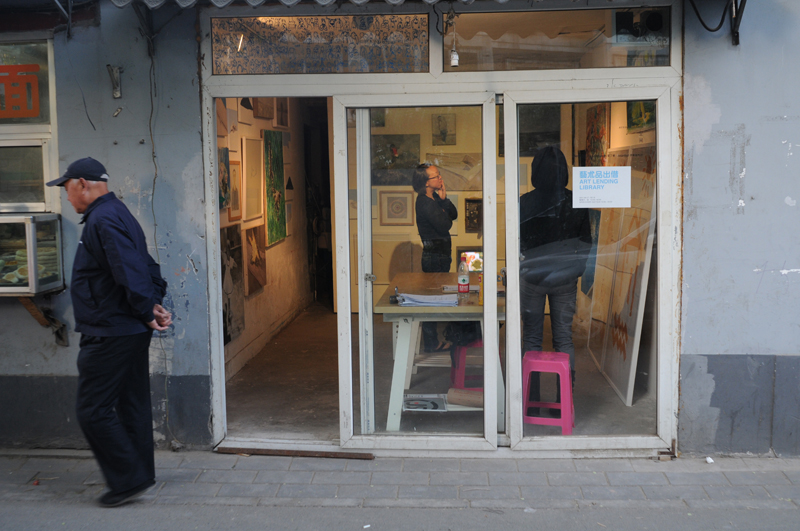《装饰》
由艺术家团体“未知博物馆”策划
2011年4月17日至5月16日
参展艺术家:
唐狄鑫,张云垚,李盛华,肖江,徐小国,刘一青,吴鼎,廖斐,陈勇为,何意达,苏畅,张宁,郑焕,朱烨,邱黯雄,吴晓航,徐江跃,石高青,陈亮洁,洛雷·凡·埃尔斯兰德(Lore Van Elslande)
箭厂空间荣幸地推出由上海艺术家团体“未知博物馆”最新策划的艺术项目《装饰》,该项目旨在以互动的方式探讨艺术价值在当下社会中如何界定等相关问题。“未知博物馆”将箭厂空间改造为一个临时的艺术品出借平台,允许观众像从图书馆借书那样短期借出空间中的艺术作品,而每件作品的出借条件由艺术家自己制定。在作品借出之后,项目成员将搜集整理相关实物和照片资料,记录项目的整个过程,观察观众如何判断作品的“价值”,以及对“装饰”和“艺术”的含义的不同理解。
从表面上看,《装饰》就像一次半常规的绘画展览:箭厂空间的三面墙上挂满了各种绘画作品,让人联想到法国沙龙展中的悬挂方式;空间中也有工作人员坐在写字台后面解答观众的相关提问。但项目真正意图探讨的问题则体现在艺术品的出借和归还的过程当中:现场展出的所有作品都可以免费出借给观众,并且每件作品都附有一份艺术家制定的出借协议,这些协议中设有各种不尽相同的条款——从押金的数额到对出借对象身份,年龄和国籍的规定——在不经意间也揭示了不同创作者之间对于作品价值判断的迥异。 艺术家相对更着眼于借出对象的身份构成,而观众看重的则是艺术在他日常生活中能够扮演的角色以及潜在的功能。观众会提出:“我为什么要把这张画带回家?”或者“花费那么大精力把画借回家,就为了挂在墙上好看?”而艺术圈内人士可能会思考:“把艺术品用做装饰用途是否会损害其本真的价值?”或者“为我们身边的环境注入新的意义本身是一件有益的事情”。除了探讨价值和审美判断的主观性之外,《装饰》项目也意在揭示两种艺术——在公共空间中展示的艺术和在私人空间中用作装饰的艺术之间存在的千丝万缕的联系。
自创立以来,“未知博物馆”通过现场装置和互动项目的策划与实施,对当代艺术如何制作和接受等相关基本问题进行探讨。他们着眼于艺术本体的观察与研究,积极地反思博物馆概念以及知识和话语的体制如何左右我们对于艺术的认知。 |
Decor
A project by the Museum of Unknown
2011.04.17 - 05.16
Participating artists:
Tang Dixin, Zhang Yunyao, Li Shenghua, Xiao Jiang, Xu Xiaoguo, Liu Yiqing, Wu Ding, Liao Fei, Chen Yongwei, He Yida, Su Chang, Zhang Ning, Zheng Huan, Zhu Ye, Qiu Anxiong, Wu Xiaohang, Xu Jiangyue, Shi Gaoqing, Chen Liangjie, Lore Van Elslande
Arrow Factory is pleased to announce the Shanghai-based Museum of Unknown’s latest undertaking—Decor—interactive work that addresses questions of value in art. Setting up Arrow Factory’s space as a provisional lending library, the project invites members of the public to borrow artworks on a temporary basis according to conditions set out by each artist. Following the rental period, material and photo records will be collected and edited together to document the process and illustrate different ways in which audiences perceive notions of value and the designations of ‘decoration’ and ‘art’.
On its surface, Decor appears as a semi-conventional painting exhibition: works are hung salon-style on three walls with a gallery associate perched at a desk nearby. However the real issues Decor confronts rest upon the fact that that each work is available “for rent” to members of the public and is accompanied by an individually crafted lending agreement designed to fulfill this purpose. Various conditions set out in the agreement—from the amount of cash deposit to stipulations pertaining to the identity, age or nationality of the borrowing party—unwittingly reveal discrepancies in how a given work’s value is perceived, both by its maker and the potential borrower. Additionally, the very act of drafting such a contract is an invaluable lesson towards contemplating complex notions of worth. As artists grapple with questions of who their audience might be, audiences appraises for themselves the role and function of art in their daily lives. Visitors may ask: why take this painting home? Or, why go through the trouble to borrow something that will just hang on my wall? And we in the art field might as easily ask: Is art in any way diminished by its place in the home? Or, can it prove beneficial in adding meaning to our surroundings? Decor seeks to address not only the highly subjective nature of value and aesthetic judgment, but also the sharp disparity between art exhibited in public space versus the art that adorns the walls of our private domain.
Since its inception, Shanghai-based artist group the Museum of Unknown has staged installations and interactive projects designed to probe fundamental questions pertaining to the making and reception of contemporary art. Focused on exploring the ontology of art, their work seeks to actively reflect upon how the role of the museum, institutions of knowledge and discourse can affect our perceptions towards art. |
